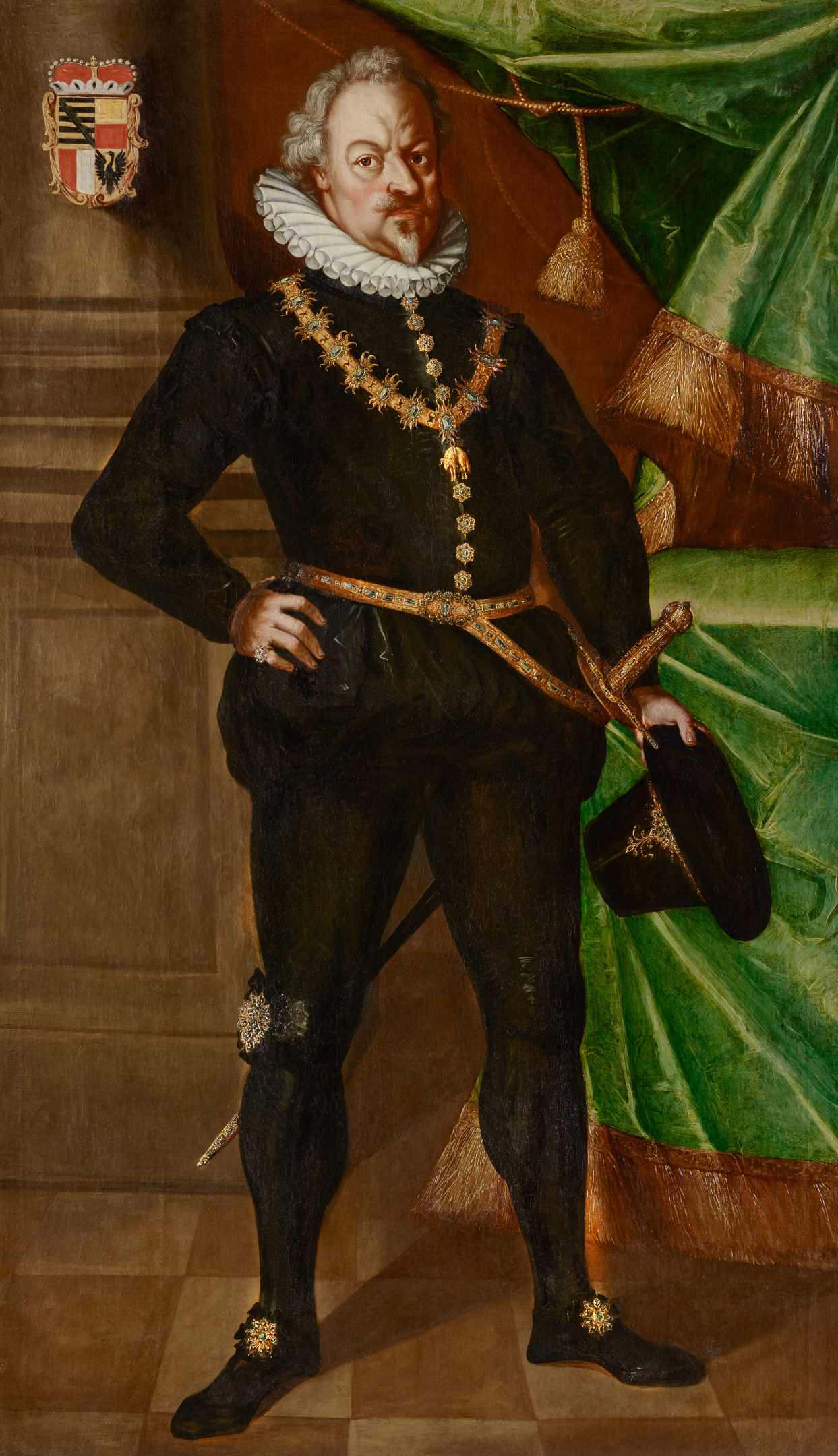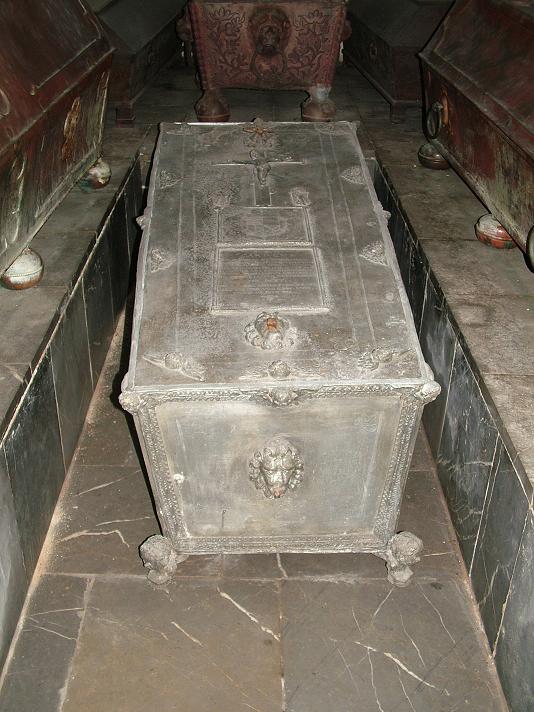by Susan Flantzer
© Unofficial Royalty 2021

Karl I, Prince of Liechtenstein; Credit – Wikipedia
Karl I, the first Prince of Liechtenstein and the founder of the Princely Family of Liechtenstein, was born on July 30, 1569, at Valtice Castle in Valtice, Moravia, now in the Czech Republic. He was the eldest of the four children and the eldest of the three sons of Hartmann II, Baron of Liechtenstein (1544 – 1585) and Countess Anna Maria of Ortenburg (1547 – 1601).
Karl had three siblings:
- Maria Judith of Liechtenstein (1575 – 1621), married Johann Joachim von Zinzendorf and Pottendorf, had five children
- Maximilian of Liechtenstein (1578 – 1645), married Baroness Katharina von Boskowitz and Černahora, the sister of his brother Karl’s wife, no children
- Gundakar of Liechtenstein (1580 – 1658), married (1) Agnes von Ostfriesland, had seven children (2) Elizabeth Lucretia, Duchess of Cieszyn, had three children

Karl’s wife Anna Maria von Boskowitz and Černahora; Credit – Wikipedia
In 1590, Karl married Baroness Anna Maria von Boskowitz and Černahora (1575 – 1625), a Moravian noblewoman, the daughter of Baron Johann von Boskowitz and Černahora and Baroness Anna von Kraigk.
Karl and Anna Maria had four children:
- Princess Anna Maria Franziska (1601 – 1640), married Maximilian, 2nd Prince of Dietrichstein, had eight children
- Princess Franziska Barbara (1604 – 1655), married Wenzel Werner of T’Serclaes, Count of Tilly, had nine children
- Prince Heinrich (died young)
- Karl Eusebius, Prince of Liechtenstein (1611 – 1684), married his niece Princess Johanna Beatrix of Dietrichstein, had nine children

Liechtenstein Castle; Credit – By Bwag – Own work, CC BY-SA 4.0, https://commons.wikimedia.org/w/index.php?curid=57858198
The House of Liechtenstein, which takes its name from Liechtenstein Castle in Lower Austria, near Vienna, built circa 1140, had ruled in the area since the 12th century. Over the centuries, the family gained land in Moravia, Lower Austria, Silesia, and Styria. Several members of the House of Liechtenstein served as close advisors to the powerful Habsburg family who were the Holy Roman Emperors from 1440 until the end of the Holy Roman Empire in 1806 except for a brief period in the 18th century.

Holy Roman Emperor Rudolf II; Credit – Wikipedia
In 1592, Karl became the treasurer of Archduke Matthias of Austria, the brother and successor of the childless Holy Roman Emperor Rudolf II. Karl and his younger brothers Maximilian and Gundakar were raised in the Evangelical Lutheran faith but they converted to Catholicism in 1599. That same year Karl became the chief judge in Moravia. In 1600, Holy Roman Emperor Rudolf II appointed Karl Chief Steward at the Imperial Court in Vienna, Austria. Four years later, Karl was appointed Governor of Moravia.

Holy Roman Emperor Matthias; Credit – Wikipedia
Besides being the elected Holy Roman Emperor, Rudolf held the traditional Habsburg territories as King of Bohemia, King of Hungary, King of Croatia, Archduke of Austria, and Margrave of Moravia. A power struggle developed between the childless Rudolf and his heir and brother Matthias. In April 1608, Matthias besieged the city of Prague and forced his brother Rudolf to negotiate and sign a peace treaty. This resulted in the redistribution of power. Rudolf kept Bohemia, Silesia, and Lusatia while Matthias received Hungary, Austria, and Moravia. Karl of Liechtenstein had supported Matthias in the power struggle. On December 20, 1608, Matthias raised Karl from Baron of Liechtenstein to Fürst of Liechtenstein (Prince), a reigning sovereign ruler or monarch. (Non-reigning descendants of a Fürst are referred to in German as Prinz (prince) or Prinzessin (princess.) Matthias was elected Holy Roman Emperor upon Rudolf’s death in 1612 and reigned until he died in 1619. In 1614, Holy Roman Emperor Matthias gave Karl another reward, the Duchy of Troppau in Silesia.

The Battle of White Mountain by Peter Snayers; Credit – Wikipedia
In November 1620, Karl and his brother Maximilian took lead roles in the imperial victory at the Battle of White Mountain near Prague during the Thirty Years War. In 1622, Karl was appointed governor and then Viceroy of the Kingdom of Bohemia. In the same year, Karl was the first member of the family to receive the Order of the Golden Fleece, a Catholic order of chivalry founded in 1430 by Philip the Good, Duke of Burgundy, to celebrate his marriage to Isabella of Portugal. The Order of the Golden Fleece still exists today with King Felipe VI of Spain as the Grand Master of the Spanish branch and Karl von Habsburg, the Head of the House of Habsburg-Lorraine, as the Grand Master of the Austrian branch. Being Catholic is no longer a requirement to become a member of the Spanish branch. Hans-Adam II, the current Prince of Liechtenstein, is a member of the Austria branch of the Order of the Golden Fleece.
Karl’s younger brother Maximilian of Liechtenstein and his wife founded a Pauline monastery and had the Church of the Nativity of the Virgin Mary built on the monastery grounds in the village of Vranov, then in Moravia, now in the Czech Republic. A crypt in the church served as the burial site for members of the House of Liechtenstein. When more room was needed for burials another crypt was built and the church then had the Old Crypt and the New Crypt.

Tomb of Karl I, Prince of Liechtenstein; Credit – Wikipedia
Karl I, Prince of Liechtenstein died on February 12, 1627, aged 57, at the Liechtenstein Palace (link in German) on Lesser Town Square in Prague, Kingdom of Bohemia, now in the Czech Republic, and was buried in the Old Crypt at Church of the Nativity of the Virgin Mary in Vranov, Moravia, now in the Czech Republic. Karl’s wife Anna Maria had predeceased him, dying at the age of 50, on June 6, 1625, in Plumov, Moravia, now in the Czech Republic. She was also buried in the Old Crypt at Church of the Nativity of the Virgin Mary.
This article is the intellectual property of Unofficial Royalty and is NOT TO BE COPIED, EDITED, OR POSTED IN ANY FORM ON ANOTHER WEBSITE under any circumstances. It is permissible to use a link that directs to Unofficial Royalty.
Liechtenstein Resources at Unofficial Royalty
- Principality of Liechtenstein Index
- Liechtenstein Links
- Liechtenstein Royal Burial Sites
- Liechtenstein Royal Residences
- Line of Succession to the Throne of Liechtenstein
- Profiles of the Princely Family of Liechtenstein
- Reigning Princes of Liechtenstein
Works Cited
- De.wikipedia.org. 2021. Karl I. (Liechtenstein) – Wikipedia. [online] Available at: <https://de.wikipedia.org/wiki/Karl_I._(Liechtenstein)> [Accessed 2 October 2021].
- En.wikipedia.org. 2021. Karl I, Prince of Liechtenstein – Wikipedia. [online] Available at: <https://en.wikipedia.org/wiki/Karl_I,_Prince_of_Liechtenstein> [Accessed 2 October 2021].
- geni_family_tree. 2021. Karl I von Liechtenstein, I. Prinz von Liechtenstein. [online] Available at: <https://www.geni.com/people/Karl-I-von-Liechtenstein-I-Prinz-von-Liechtenstein/5068560487790089757> [Accessed 2 October 2021].
- Princely House of Liechtenstein. 2021. Biographies of all Reigning Princes – 17th century. [online] Available at: <https://fuerstenhaus.li/en/die-biographien-aller-fuersten/17-century/> [Accessed 2 October 2021].
